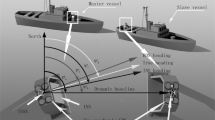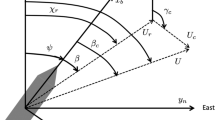Abstract
Lengthening the baseline between antennas and compensating for heading error caused by vessel motion are two challenges encountered in using global positioning system (GPS) information to estimate the heading of a sailing vessel. In this study, a heading determination system (HDS), which consists of two quadruple GPS antenna arrays, an inertial navigation system (INS), and a total station surveying apparatus (TSSA), was developed to build a dynamic long baseline between two vessels. A heading determination algorithm is then presented based on the HDS. A heading error model, which considers TSSA time delay, is also designed to compensate for heading error and improve heading accuracy. The proposed algorithm has been examined by conducting mooring and sea tests. Test results are compared with the high-accuracy heading reference provided by the same INS. The standard deviations (std) of the heading error in the mooring and sea tests are ±6″ and ±17″, respectively. After parameter identification and error compensation using the heading error model, the heading error in the sea test is reduced to ±8″ from ±17″, thus proving the effectiveness of the proposed error compensation method. The experimental results demonstrate the capability of the HDS for high-performance shipborne heading determination.











Similar content being viewed by others
Explore related subjects
Discover the latest articles, news and stories from top researchers in related subjects.References
Barbour N (2001) Inertial components—past, present and future. In: Proceedings of AIAA GN&C conference, Montreal, QC, Canada, Aug 1–11
Britting KR (1971) Inertial navigation system analysis. Wiley, New York, pp 109–152
Cannon ME, Sun H (1996) Experimental assessment of a non-dedicated GPS receiver system for airborne attitude determination. ISPRS J Photogramm Remote Sens 51(2):99–108
Giorgi G, Teunissen PJG, Gourlay TP (2012) Instantaneous global navigation satellite system (GNSS)-based attitude determination for maritime applications. IEEE J Ocean Eng 37(3):348–362
Griffith G, King BA, Cooper EB (1994) Precise measurements of ship’s attitude using satellite navigation. In: Sixth international conference on electronic engineering in oceanography. Cambridge, UK, 21 July, pp 6–10
Han JY, Guo J, Liu RY (2013) Alternative algorithm for determining the attitude parameters of a moving platform using multi-antenna GNSS sensors. J Surv Eng 139(4):194–201
Johnson G, Waid J, Primm M, Aggerwal R (2012) Ship attitude accuracy trade study for aircraft approach and landing operations. In: IEEE/ION Position location and navigation symposium (PLANS), Myrtle Beach, SC, Apr 23–26, pp 783–790
Lau L, Cross P, Steen M (2012) Flight tests of error-bounded heading and pitch determination with two GPS receivers. IEEE Trans Aerosp Electron Syst 48(1):388–404
Leick A (2004) GPS satellite surveying, 3rd edn. Wiley, New York, p 42
Li Y, Efatmaneshnik M, Dempster AG (2012) Attitude determination by integration of MEMS inertial sensors and GPS for autonomous agriculture applications. GPS Solut 16(1):41–52
Mongrédien C, Schleppe JB, Lachapelle G et al (2008) Efficient dual-frequency ambiguity resolution algorithm for GPS-based attitude determination. J Surv Eng 134(3):67–75
Nash RA, Levine SA, Roy KJ (1971) Error analysis of space-stable inertial navigation systems. IEEE Trans Aerosp Electron Syst 7(4):617–629
Reis J, Sanguino J, Rodrigues A (2012) Baseline influence on single-frequency GPS precise heading estimation. Wirel Pers Commun 64(1):185–196
Trimble (2007) Trimble S8 total station. Datasheet. Trimble, Dayton, pp 1–4
Weston JL, Titterton DH (2000) Modern inertial navigation technology and its application. Electron Commun Eng J 12(2):49–64
Acknowledgments
The authors would like to thank the anonymous reviewers and editors for their patient work and constant encouragement. We would also like to thank Rong Zhang, Yonggui Dong, Wenke Xiao, and Zongyuan Yang for their useful comments and cordial help.
Author information
Authors and Affiliations
Corresponding author
Rights and permissions
About this article
Cite this article
Hu, P., Gao, Z., She, Y. et al. Shipborne heading determination and error compensation based on a dynamic baseline. GPS Solut 19, 403–410 (2015). https://doi.org/10.1007/s10291-014-0399-z
Received:
Accepted:
Published:
Issue Date:
DOI: https://doi.org/10.1007/s10291-014-0399-z




